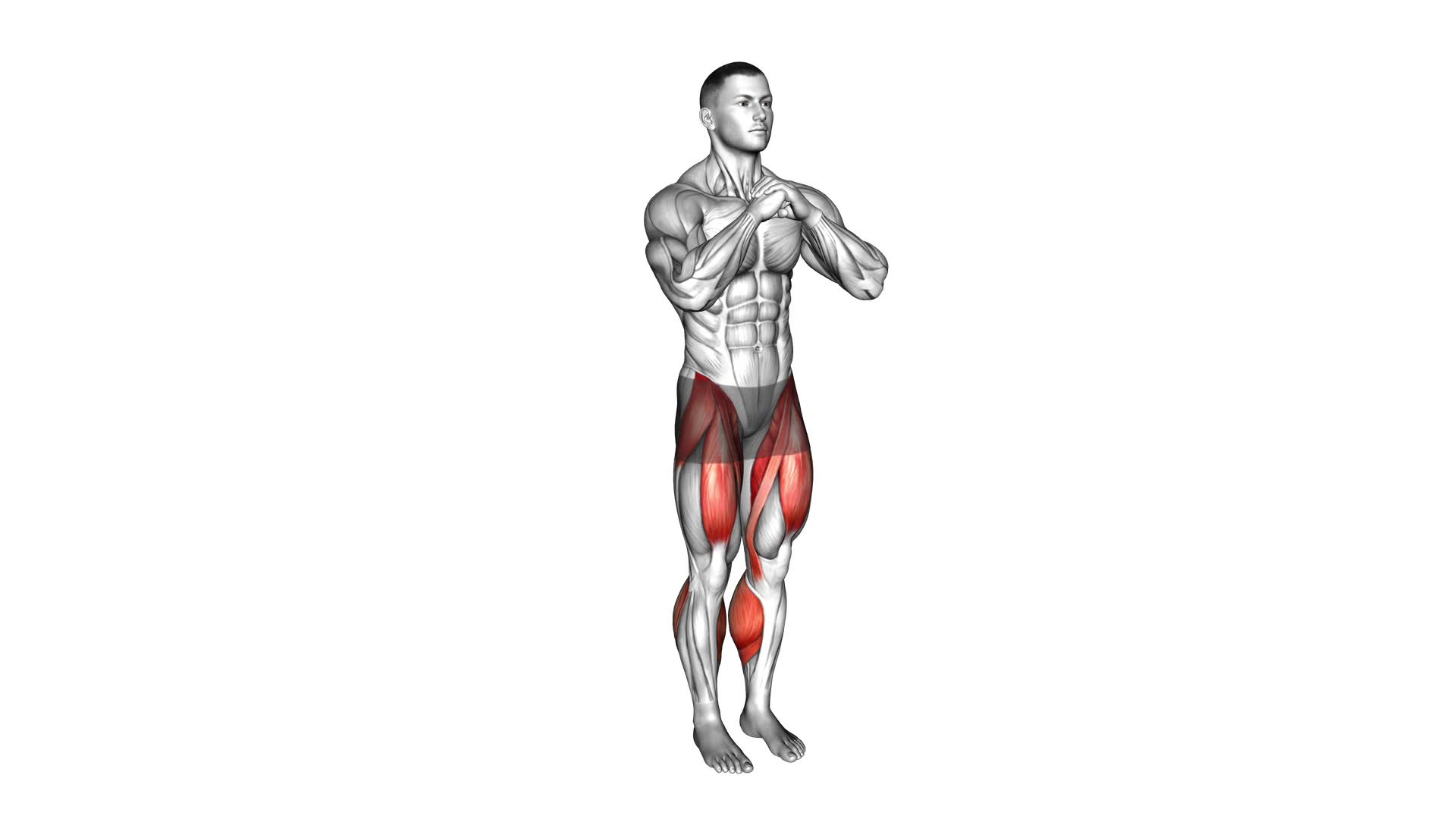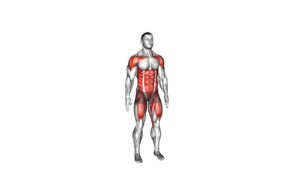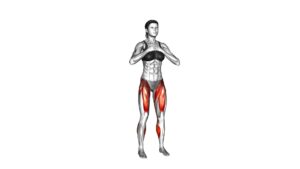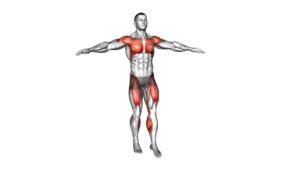Front Leg Kick (male) – Video Exercise Guide & Tips

Are you looking to improve your front leg kick? Look no further!
Watch This Exercise Video
This video exercise guide and tips will help you master the technique and increase your kicking power.
With proper stance and balance, step-by-step execution, and valuable tips, you'll be kicking like a pro in no time.
Don't miss out on the chance to take your martial arts skills to the next level.
Let's get started!
Key Takeaways
- Targets multiple muscle groups simultaneously
- Develops strength, power, and flexibility
- Improves leg strength, balance, and coordination
- Enhances speed, accuracy, and power in kicking technique
Benefits of the Front Leg Kick
One key benefit of performing the front leg kick is that it targets multiple muscle groups simultaneously, providing a comprehensive lower body workout. This martial arts technique, when executed correctly, engages muscles in the hips, thighs, and core, helping to develop strength, power, and flexibility. The front leg kick technique involves lifting the knee and extending the leg forward, striking the target with the ball of the foot or the shin.
By incorporating this move into your training routine, you can enhance your leg strength and improve your balance and coordination.
To maximize the benefits of the front leg kick, it's important to practice proper form and technique. Start by standing with your feet shoulder-width apart, and then lift your knee towards your chest while keeping your core engaged. As you extend your leg forward, aim to strike the target with the ball of your foot or the shin. Remember to maintain control and balance throughout the movement.
Additionally, incorporating front leg kick training methods such as shadow boxing, kicking drills, and heavy bag work can help to improve your speed, accuracy, and power.
Proper Stance and Balance
To maintain proper stance and balance during the front leg kick, position your feet shoulder-width apart and engage your core while executing the move. This stance provides a solid foundation, allowing you to generate power and maintain stability throughout the exercise. By keeping your feet shoulder-width apart, you create a balanced base that helps distribute your weight evenly. Engaging your core muscles, such as your abdominals and lower back, enhances stability and improves your overall balance.
Improving stability is crucial during the front leg kick as it ensures proper execution and reduces the risk of injury. When you have a stable stance, you can focus on delivering a powerful kick without compromising your balance. This stability also allows you to maintain control over your movements, which is essential for accuracy and precision.
In addition to stability, enhancing flexibility is essential for executing the front leg kick effectively. Flexibility in the hips and legs allows for a greater range of motion, enabling you to generate more power and height in your kick. Stretching exercises that target the hip flexors, quadriceps, and hamstrings can help improve flexibility and enhance the execution of the front leg kick.
Step-by-Step Execution
Now let's break down the step-by-step execution of the front leg kick.
First, you'll be shown the proper form demonstration to ensure you understand the correct technique.
Next, we'll highlight common mistakes to avoid, helping you refine your execution and maximize the effectiveness of the exercise.
Proper Form Demonstration
Start by positioning yourself in a stable stance, with your front leg slightly bent and your back leg straight. This is the foundation for executing a proper front leg kick.
Many people have misconceptions about the correct form for this kick, but it's essential to maintain balance and stability throughout the movement.
As you kick, extend your front leg forward, aiming to strike with the top of your foot or the shin. Keep your core engaged and your upper body upright to maximize power and maintain control.
Remember to pivot on your support leg for added stability and to generate rotational force. By following these guidelines, you can perform various front leg kick variations effectively.
Now, let's move on to the next section and discuss common mistakes to avoid.
Common Mistakes to Avoid
To ensure proper execution of the front leg kick, it's crucial to be aware of common mistakes to avoid in the step-by-step process.
One common mistake isn't maintaining balance. It's important to keep your standing leg stable while performing the kick to generate power and accuracy.
Another mistake isn't pivoting on the supporting foot. This pivot helps to generate additional power and allows for a smooth transition from the kick to the recovery phase.
Lastly, some people tend to drop their guard during the kick, leaving themselves vulnerable to counterattacks.
To improve your front leg kick, focus on maintaining balance, pivoting on the supporting foot, and keeping your guard up throughout the movement.
These techniques for improvement will help you execute the front leg kick effectively and efficiently.
Benefits of This Exercise
To fully understand the benefits of the front leg kick, it's important to break down the step-by-step execution and highlight how it can improve your overall martial arts skills.
One of the key benefits of this exercise is that it helps in improving flexibility. The front leg kick requires a good range of motion in the hip and hamstring muscles, and practicing this kick regularly can help increase your flexibility in these areas.
Additionally, this exercise also aids in injury prevention. By regularly performing the front leg kick, you can strengthen the muscles in your legs, which can help protect your joints from potential injuries.
Common Mistakes to Avoid
Avoid these common mistakes when performing the front leg kick exercise.
To ensure proper execution, it's important to be aware of these errors and take steps to correct them.
One common mistake isn't maintaining proper balance throughout the movement. It's essential to engage your core and keep your body centered during the kick. Failing to do so can lead to loss of control and potentially cause injury.
Another mistake to avoid is neglecting to fully extend your leg during the kick. To optimize power and effectiveness, make sure to fully extend your leg, aiming for a straight line from your hip to your toes.
Additionally, rushing through the movement is a common error that can compromise your form. Take your time and focus on executing each step with precision.
Lastly, be mindful of your foot placement. Placing your foot too far away or too close to your target can affect the accuracy and effectiveness of your kick. Pay attention to your technique and make adjustments as necessary to improve your performance.
Tips for Increasing Kicking Power
Maintain proper balance and fully extend your leg to increase the power of your front leg kick. To improve your kicking power, here are three key tips:
- Strengthen your leg muscles: Engage in exercises specifically targeting your legs, such as squats, lunges, and calf raises. These exercises help build strength and power, allowing you to generate more force in your kicks. Additionally, incorporating plyometric exercises like box jumps and jump squats can enhance explosive power, leading to faster and more powerful kicks.
- Improve flexibility: Flexibility is crucial for increasing kicking speed and power. Stretching exercises like leg swings, hamstring stretches, and hip openers can help improve the range of motion in your legs, allowing for more powerful and fluid kicks. Incorporating dynamic stretches before your training sessions can also help warm up your muscles and improve overall flexibility.
- Practice proper technique: Focus on proper form and technique when performing your front leg kicks. This includes maintaining a strong core, pivoting on your supporting leg, and generating power from your hips. By practicing proper technique, you can optimize the transfer of force from your body to your kick, increasing the power behind each strike.
Advanced Variations and Drills
Now that you have mastered the basics of the front leg kick, it's time to take it to the next level with advanced variations and drills. These challenging progressions are designed to push you beyond your limits and enhance your technique.
By incorporating these drills into your training routine, you won't only improve your kicking power, but also develop greater speed, accuracy, and flexibility.
Challenging Progressions for Experts
Take your front leg kick to the next level with these advanced variations and drills. Here are some challenging progressions for experts to enhance your technique and maximize your training:
- Dynamic Plyometric Kicks: Incorporate explosive movements into your front leg kicks to increase power and speed. Perform jump kicks, where you explosively jump off the ground while executing the kick, or switch kicks, where you switch your stance mid-air and deliver a powerful kick.
- Target Specific Training: Focus on specific targets to improve accuracy and precision. Practice hitting moving targets or small targets placed at different heights and angles. This will enhance your ability to adapt and hit your opponent effectively during a fight.
- Combination Kicks: Combine your front leg kick with other techniques to create unpredictable and powerful combinations. Experiment with different strikes, such as punches or knee strikes, to keep your opponent guessing and increase your offensive arsenal.
Enhancing Technique Through Drills
To further enhance your technique, incorporate advanced variations and drills into your front leg kick training. These drills are designed to improve accuracy and develop speed, taking your kick to the next level.
One effective drill is the target practice drill, where you aim for specific spots on a punching bag or focus pads. This will help you hit your target with precision and increase your overall accuracy.
Another drill to try is the speed drill, where you perform rapid front leg kicks in quick succession. This will challenge your muscles to react faster and improve your kicking speed.
Remember to focus on maintaining proper technique and form while executing these drills. With consistent practice, you'll see significant improvements in your front leg kick.
Frequently Asked Questions
How Long Does It Take to Master the Front Leg Kick?
To master the front leg kick, it takes time and dedication. Martial arts training focuses on perfecting techniques like the front leg kick, which requires balance, strength, and accuracy.
With consistent practice and proper form, you can improve your skills over time. It's important to remember that everyone progresses at their own pace, so don't get discouraged if it takes longer for you to master the front leg kick.
Keep training and you'll see progress.
Are There Any Specific Stretches or Warm-Up Exercises Recommended Before Attempting the Front Leg Kick?
Before attempting the front leg kick, it's essential to do specific stretches and warm-up exercises. These activities help prepare your muscles and increase flexibility, reducing the risk of injury.
Incorporating stretches like hamstring stretches and hip flexor stretches can improve your range of motion. Additionally, performing warm-up exercises such as jogging or jumping jacks can increase blood flow and raise your body temperature.
Can the Front Leg Kick Be Used Effectively in Self-Defense Situations?
In self-defense situations, the front leg kick can be an effective technique. It allows you to strike your opponent quickly and maintain distance.
The advantage of using the front leg kick is that it can surprise your attacker, as they may not expect a strike coming from your front leg. Additionally, it can be used to target sensitive areas such as the groin or lower abdomen, causing significant pain and temporarily immobilizing your attacker.
What Are Some Recommended Training Drills to Improve Speed and Accuracy of the Front Leg Kick?
To improve the speed and accuracy of your front leg kick, there are some recommended training techniques you can try.
First, focus on proper footwork and balance to generate power.
Practice kicking drills that target a specific spot or target, gradually increasing speed and force.
It's important to avoid common mistakes like telegraphing your kick or neglecting to retract your leg quickly.
Are There Any Modifications or Adaptations for Individuals With Limited Flexibility or Mobility in Their Legs?
If you have limited flexibility or mobility in your legs, there are modifications and adaptations you can make for the front leg kick.
You can try alternative exercises that focus on improving leg strength and flexibility, such as lunges or standing leg lifts.
Additionally, you can use props like resistance bands or a chair for support during the kick.
Remember to consult with a fitness professional to ensure you're performing the exercises correctly and safely.
Conclusion
In conclusion, the front leg kick is a powerful exercise that offers numerous benefits. By maintaining a proper stance and balance, executing the kick step-by-step, and avoiding common mistakes, you can maximize its effectiveness.
Additionally, incorporating tips for increasing kicking power and exploring advanced variations and drills can take your front leg kick to the next level.
Incorporate this exercise into your routine to strengthen your lower body and improve your overall fitness.

Author
Years ago, the spark of my life’s passion ignited in my mind the moment I stepped into the local gym for the first time. The inaugural bead of perspiration, the initial endeavor, the very first surge of endorphins, and a sense of pride that washed over me post-workout marked the beginning of my deep-seated interest in strength sports, fitness, and sports nutrition. This very curiosity blossomed rapidly into a profound fascination, propelling me to earn a Master’s degree in Physical Education from the Academy of Physical Education in Krakow, followed by a Sports Manager diploma from the Jagiellonian University. My journey of growth led me to gain more specialized qualifications, such as being a certified personal trainer with a focus on sports dietetics, a lifeguard, and an instructor for wellness and corrective gymnastics. Theoretical knowledge paired seamlessly with practical experience, reinforcing my belief that the transformation of individuals under my guidance was also a reflection of my personal growth. This belief holds true even today. Each day, I strive to push the boundaries and explore new realms. These realms gently elevate me to greater heights. The unique combination of passion for my field and the continuous quest for growth fuels my drive to break new ground.







